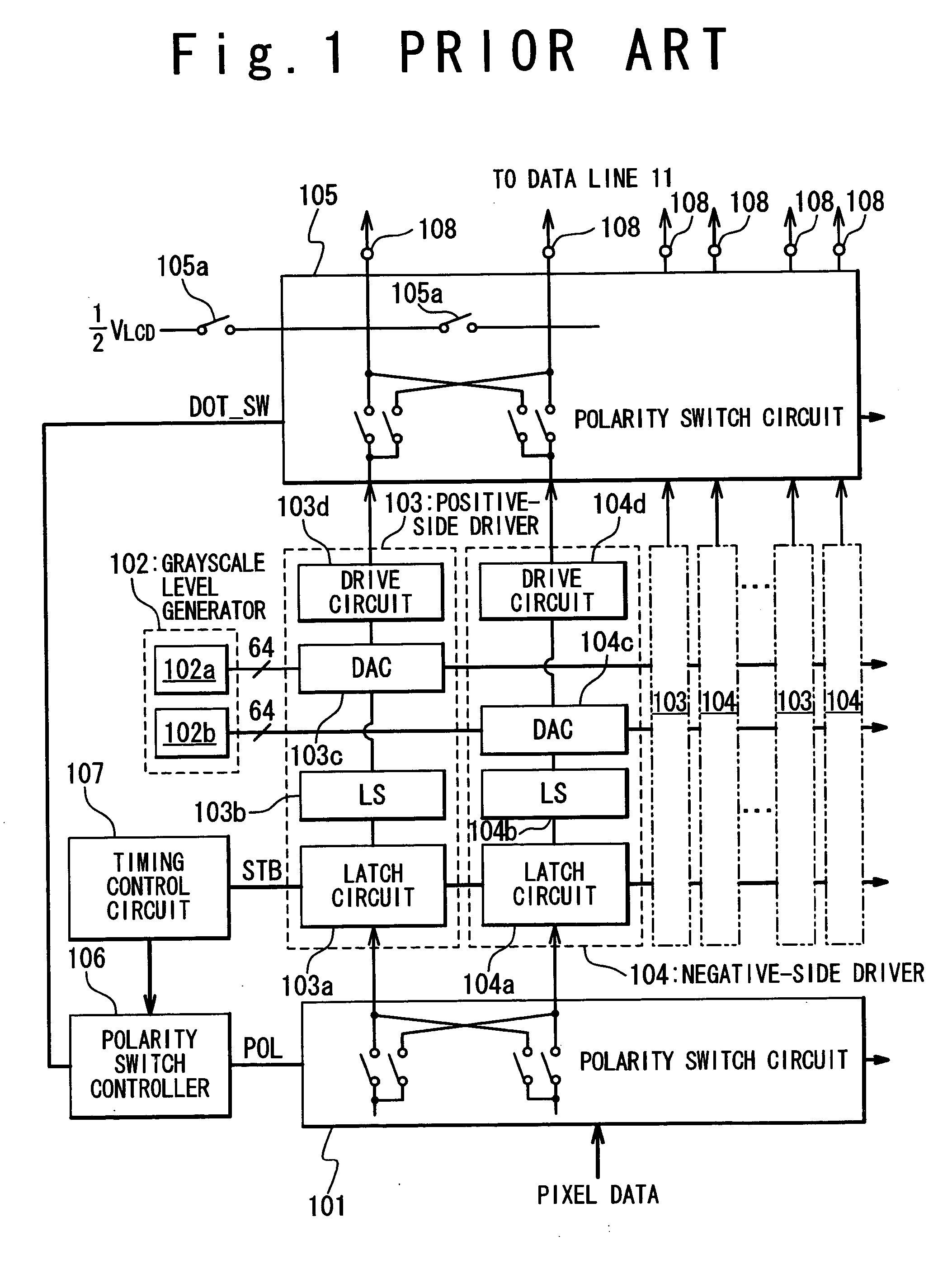Liquid crystal display for implmenting improved inversion driving technique
- Summary
- Abstract
- Description
- Claims
- Application Information
AI Technical Summary
Benefits of technology
Problems solved by technology
Method used
Image
Examples
first embodiment
(Structure of LCD Apparatus)
[0041]FIG. 3 is a diagram illustrating an exemplary structure of an LCD apparatus 10 in a first embodiment of the present invention. The LCD apparatus 10 is composed of an LCD panel 1, and an LCD driver 2. The LCD panel 1 is composed of data lines 11, gate lines 12, and pixels 13 arranged at respective intersections of the data lines 11 and the gate lines 12. The data lines 11 are connected with input terminals 16, and receive data signals from the LCD driver 2 through the input terminals 16. The gate lines 12 are used for selecting rows (or lines) of the pixels 13. When the pixels 13 on a selected line are driven with data signals, one of the gate lines 12 associated with the selected line is activated. The pixels 13 are each composed of a TFT (thin film transistor) 13a, and a pixel electrode 13b opposed to a common electrode 13c. Liquid crystal material is filled between the pixel electrodes 13b and the common electrode 13c, and the pixel electrodes 1...
second embodiment
(LCD Apparatus Structure)
[0077]FIG. 10 is a block diagram illustrating an exemplary structure of an LCD apparatus 10A in a second embodiment of the present invention. The structure of the LCD apparatus 10A in the second embodiment is similar to that of the LCD apparatus 10 in the first embodiment; the positive-side driver circuitries 23 are designed to develop data signals of the positive polarity with respect to the ground level of the LCD driver 2, and the negative-side driver circuitries 24 are designed to develop data signals of the negative polarity with respect to the ground level of the LCD driver 2. As mentioned above, such architecture effectively reduces the power consumption of the LCD driver 2.
[0078] The difference is that the LCD driver 10A in the second embodiment adopts a time-divisional driving technique, which involves time-divisionally driving pixels in the same line through sequentially selecting data lines. The time-divisional driving technique is widely used ...
operation example
[0090]FIG. 13 is a timing charge illustrating an exemplary operation of the LCD apparatus 1OA in this embodiment.
[0091] At the beginning of an m-th horizontal period, the pixel data associated with the pixels on the selected line are inputted to the input-side polarity switch circuitry 21, and the polarity signal POL and the switch control signal DOT_SW are switched. This allows the polarity switch circuitries 21 and 25 to switch the connections therein in accordance with the polarities of the data signals supplied to the respective data lines 11 during the m-th horizontal period. Additionally, the latch signal STB is activated to latch the pixel data into the latch circuits 23a and 24a within the positive-side and negative side driver circuitries 23 and 24.
[0092] Furthermore, all of the precharge control signal GND_SW and the control signals RSW, GSW, and BSW are activated at the beginning of the m-th horizontal period to turn on the R switches 18, the G switches 19, and the B sw...
PUM
 Login to View More
Login to View More Abstract
Description
Claims
Application Information
 Login to View More
Login to View More - R&D
- Intellectual Property
- Life Sciences
- Materials
- Tech Scout
- Unparalleled Data Quality
- Higher Quality Content
- 60% Fewer Hallucinations
Browse by: Latest US Patents, China's latest patents, Technical Efficacy Thesaurus, Application Domain, Technology Topic, Popular Technical Reports.
© 2025 PatSnap. All rights reserved.Legal|Privacy policy|Modern Slavery Act Transparency Statement|Sitemap|About US| Contact US: help@patsnap.com



